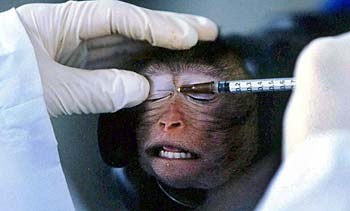|
Companies that DO test
Great Animal Welfare Site!
Animal Cruelty-Free Info
Scientific Alternatives Report
Added March 27th, 2009
** This is an essay i wrote in mid-October, 2008 for my english
class. It specifically deals with animal testing. What do you think? **
Animal Testing
The environment of an animal testing laboratory is surprisingly concealed from the real world.
What animals actually have to go through in these places are unbelievable. How would you like to be burned alive? Or strapped
down and cut to pieces while awake? Some animals are even knocked against the head with incredible force and suffer severe
brain damage. To display that there are no differences in eye protein levels, animal’s eyelids are sewn shut and later
compared to normal protein levels. Also, certain drugs administered to animals result in organ failure. Even cosmetic companies
are torturing millions of animals each year. Most of these animals that are used for testing are often taken from their mothers’
right after birth and tortured until they are left with “psychological damage and social maladjustment” (Paws_n_Tails.
Par. 16). All of this goes on for only one reason; so that people are able to buy prescriptions, cleaning supplies, and other
toxic items we use on a day-to-day basis.
Not only
is animal testing cruel, but it’s also very non-beneficial to people. Today, many citizens don’t realize that
the American public alone pays “$136 billion a year for this torturous practice; that’s
$300 per family” (Paws_n_Tails. Par. 4), and it all comes out of our taxes. However, less than half of all animal tests prove accurate for
human-use. Talk about a waste of money, time, and resources! The tests are not accurate simply because animals
and humans are completely different from each other, metabolically, anatomically, genetically and psychologically”
(Paws_n_Tails. Par. 10).

|
| (Injections being tested on a monkey's eyes) |
For example, when testing in cats for pain medication such as ibuprofen, the results for the cats are deadly because
they lack an enzyme that makes it impossible for them to metabolize it. However, the result in humans is completely different
because we have that enzyme and are able to metabolize it. Another example would be testing in dogs with their circulatory
system. Dogs and humans have different circulatory systems merely because they walk on four legs
and we walk
on two.
Animals are not
commonly thought of being tested for other animals’ medicines, but this actually occurs quite frequently. However, this
process is almost always inaccurate. About 30% of the time can a cure for a disease for rats, cure a disease in mice. On the
other hand, many companies are trying to either cut down on animal tests or getting rid of them altogether.
This is not always
the case for some companies. Some are required by law to test on animals and have no choice. Others just lie on their labels
saying that they don’t test, even though they do. However, this is a big risk for the businesses. Companies and their
managers know how strongly people disagree with animal testing. Therefore, if the society were to find a company testing after
they publicly stated that they were not, the company would face a “public relations disaster” (Caring Consumer.
Par. 5).

|
| (NON TESTING COMPANIES!!) |
Nevertheless, the public and its companies are trying new options, many of which are either testing-free or limited testing.
One example of a testing-free option is the Bovine Corneal Opacity and Permeability Test Method, or BCOP. This procedure is
used mostly for the testing of eye irritants, but it uses tissues obtained from slaughterhouses instead of the use of live
animals, which drastically cuts down the number of abused and tortured animals. Another method is the EpiDerm system, which
is used for skin-related experiments. The EpiDerm is basically a layered model of human skin, but instead of skin, labs use
keratin. There is also the Corrositex method. In some instances this can replace the use of rabbits, but it is often associated
with the use of them. This strategy uses a “biomembrane and chemical detection system that changes color when it touches
acidic materials.” (American Anti-Vivisection Society. Par. 2).
Even though there
are a few things being done about this cruel and ineffective process, it’s not enough to save the 25 to 50 billion animals
that die each year. We need to take action on the testing labs and inform today’s society about what exactly is behind
all of this. If you have a beloved pet at home, just imagine if it was in a dark and scary lab, being strapped down to an
unsanitary table and cut alive. It’s not a very pleasant thought. That’s why we need a change to save the wonderful
animals that are trapped in cramped cages awaiting their death; the animals that don’t have a chance at life.
Bibliography
- "Companies That Don't Test On Animals". Caring Consumer. 2008 <http://www.caringconsumer.com/pdfs/companiesDontTest.pdf>.
- "Animal Testing - Facts". Paws_n_Tails. <http://www.geocities.com/paws_n_tails/AnimalTestingFacts.html>.
- "Testing Alternatives". American Anti-Vivisection Society. 2008 <http://www.aavs.org/testing03.html>.
|
